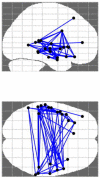This is a preprint.
Extremely Preterm Children Demonstrate Interhemispheric Hyperconnectivity During Verb Generation: a Multimodal Approach
- PMID: 33173877
- PMCID: PMC7654860
- DOI: 10.1101/2020.10.30.20222448
Extremely Preterm Children Demonstrate Interhemispheric Hyperconnectivity During Verb Generation: a Multimodal Approach
Update in
-
Extremely preterm children demonstrate hyperconnectivity during verb generation: A multimodal approach.Neuroimage Clin. 2021;30:102589. doi: 10.1016/j.nicl.2021.102589. Epub 2021 Feb 12. Neuroimage Clin. 2021. PMID: 33610096 Free PMC article.
Abstract
Children born extremely preterm (EPT, <28 weeks gestation) are at risk for delays in development, including language. We use fMRI-constrained magnetoencephalography (MEG) during a verb generation task to assess the extent and functional connectivity (phase locking value, or PLV) of language networks in a large cohort of EPT children and their term comparisons (TC). 73 participants, aged 4 to 6 years, were enrolled (42 TC, 31 EPT). There were no significant group differences in age, sex, race, ethnicity, parental education, or family income. There were significant group differences in expressive language scores (p<0.05). Language representation was not significantly different between groups on fMRI, with task-specific activation involving bilateral temporal and left inferior frontal cortex. There were group differences in functional connectivity seen in MEG. To identify a possible subnetwork contributing to focal spectral differences in connectivity, we ran Network Based Statistics analyses. For both beta (20-25 Hz) and gamma (61-70 Hz) bands, we observed a subnetwork showing hyperconnectivity in the EPT group (p<0.05). Network strength was computed for the beta and gamma subnetworks and assessed for correlation with language performance. For the EPT group, exclusively, strength of the subnetwork identified in the gamma frequency band was positively correlated with expressive language scores (r=0.318, p<0.05). Thus, interhemispheric hyperconnectivity is positively related to language for EPT children and might represent a marker for resiliency in this population.
Conflict of interest statement
Figures





Similar articles
-
Extremely preterm children demonstrate hyperconnectivity during verb generation: A multimodal approach.Neuroimage Clin. 2021;30:102589. doi: 10.1016/j.nicl.2021.102589. Epub 2021 Feb 12. Neuroimage Clin. 2021. PMID: 33610096 Free PMC article.
-
Functional Hyperconnectivity during a Stories Listening Task in Magnetoencephalography Is Associated with Language Gains for Children Born Extremely Preterm.Brain Sci. 2021 Sep 26;11(10):1271. doi: 10.3390/brainsci11101271. Brain Sci. 2021. PMID: 34679336 Free PMC article.
-
Extracallosal Structural Connectivity Is Positively Associated With Language Performance in Well-Performing Children Born Extremely Preterm.Front Pediatr. 2022 Mar 18;10:821121. doi: 10.3389/fped.2022.821121. eCollection 2022. Front Pediatr. 2022. PMID: 35372163 Free PMC article.
-
Extremely preterm children exhibit increased interhemispheric connectivity for language: findings from fMRI-constrained MEG analysis.Dev Sci. 2018 Nov;21(6):e12669. doi: 10.1111/desc.12669. Epub 2018 Apr 16. Dev Sci. 2018. PMID: 29659125 Free PMC article.
-
Functional Brain Connectivity of Language Functions in Children Revealed by EEG and MEG: A Systematic Review.Front Hum Neurosci. 2020 Mar 12;14:62. doi: 10.3389/fnhum.2020.00062. eCollection 2020. Front Hum Neurosci. 2020. PMID: 32226367 Free PMC article.
References
-
- Barre N., Morgan A., Doyle L. W., & Anderson P. J. (2011). Language abilities in children who were very preterm and/or very low birth weight: a meta-analysis. J Pediatr, 158(5), 766–774 e761. - PubMed
Publication types
Grants and funding
LinkOut - more resources
Full Text Sources
Miscellaneous
